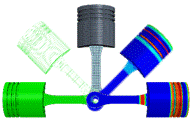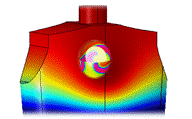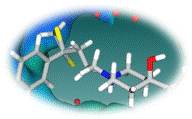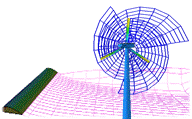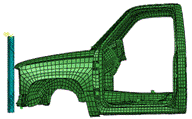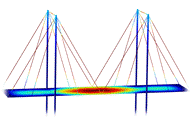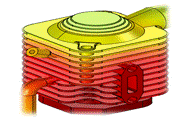ADVANCED ENGINEERING SIMULATION
Computational mechanics is a boundless tool for first time right engineering product development. Engineering simulation played a critical role in the evolution of scientific predictive methods and business wealth creation cycle. Computational mechanics is grown as a trusted tool for cost effective product development with a reduced cycle time. Currently, Computer Aided Engineering (CAE) developments is aimed towards Industrial innovation to lead in the creative economy. Material unity, divergence and convergence of engineering science developments are the drivers for the advances in Engineering Simulations. The computational mechanics of multi scale, multi physics and multi material modelling is our core research and innovation focus area for advanced engineering Simulations.
Computational Multiphysics Modelling
Computer Aided Engineering simulations are extensively used for new product development and performance enhancement of existing products. These simulations are dominated by single physics based design due to the resource and technology constraints. The multiphysics based simulation methodology is increasingly used for design and optimisation for multiple product requirements. Recent developments in multiphysics modeling methodology and tools will be researched and translated as Innovative product design solutions for our clients.
The core of computational modelling comprises, Computational Structural Mechanics (CSM), Computational Fluid Dynamics (CFD) and Computational Electromagnetics (CEM) and are governed by Theory of elasticity, Navier-stokes and Maxwell equations, respectively. Our focus is on methods that couple these equations efficiently at PDE level and helps to solve the industrial problems, leveraging a single CAD model. Most of the Industrial products which can benefit from Multiphysics modelling to meet multiple product requirements.
Computational Multiscale Modelling
One of the specialty of ATOA Scientific Technologies after multiphysics modelling, is Multiscale modeling for both length and time scale for applications engineered from atomic level. Multiscale model is a mathematical model formed by combining partial models at different length and time scales. There are four length scales material models, continuum mechanical or macro models, microstructure or micro mechanical models, atomistic or molecular mechanics models and electronic structure or quantum mechanical models. These models span from macro to micro to nanometer length scales. The multi scale modelling will cover the length and time scale linking of nano mechanics to micro mechanics to macro continuum mechanics for product development engineered from atomic scale. A Journey through length scale starts from sub atomic particle to atoms to molecules to compounds to materials to products to engineering applications. The macro engineering behavior is the cumulative effect starting from the subatomic particles.
We have superior models to solve problems at each level and methods for efficient linking through multiple length and time scale levels. Various models are available in predicting the properties and performance at both length and time scale from nano to micro to macro scale properties. Linking the length and time scale allows us to probe macro engineering behavior into the atomic level origin. Recent developments in Multiscale modeling make this as a practical possibility for solving real engineering problem. The Multiscale modeling ultimate objective is to connect to the atomic level from the macro world. However, for many applications even if we step one up or down is good for exploiting the Multiscale modeling capability. For examples, stepping down one scale for composites will help us to leverage micromechanics for designing composites at constituent level. Similarly, damage mechanics can help us study the damage at fiber and matrix level than a homogenized laminate level for accurate and reliable prediction of failure.
Multiscale models for material failure or product performance prediction from atomic level, Thermal performance of material from molecular level for super insulation and extremal thermal conductivity for energy and cost efficient building thermal management. Accurate Medical diagnostics and therapy by modelling from cellular to tissue to organ to human level. Maximisation of solar energy harvesting by modelling from photon to semiconductor to solar laminates, solar Panels to solar grid to environmental level.
Computational Multimaterial Modelling
Any real life product is multimaterial in nature. Engineered products are also using various materials to meet functional requirements. Metal, ceramic, polymers and their composites are used efficiently. Material behaviour are different and are captured by linear elastic, nonlinear elastic, hyperelastic, plastic, viscoelastic, thermoelastics material constitutive equations. Coupling these equations for product design without any coupled effect is critical for first time right product design. For Example, composites with anisotropic elastic coupling can produce undesired warping. Structural material can fail due to thermal forces. Electromagnetic coupling can produce unwanted interference and failure. Further, when we join materials, the interface produces sharp variation in internal parameter and resultants. Graded interface is desired for long life and trouble free performance. Multi material product design is another important simulation design solution for multifunctional product design.
ATOA Scientific Technologies leverage the "T Technology growth" Model to build core depth and width in multiphysics , multiscale and multimaterial modeling for our client benefits. Do mail us for your advanced engineering simulations at http://cae.atoa.com/contact-resources/contact-form .

